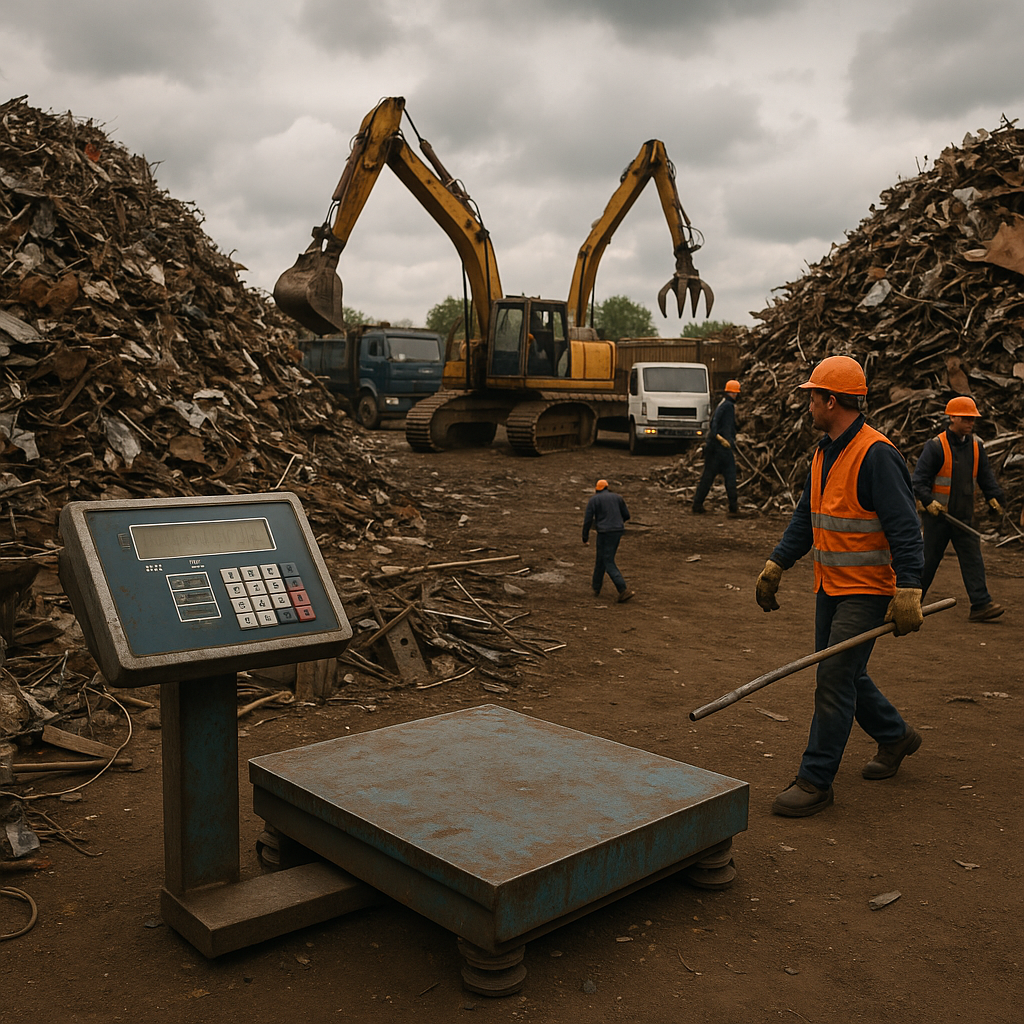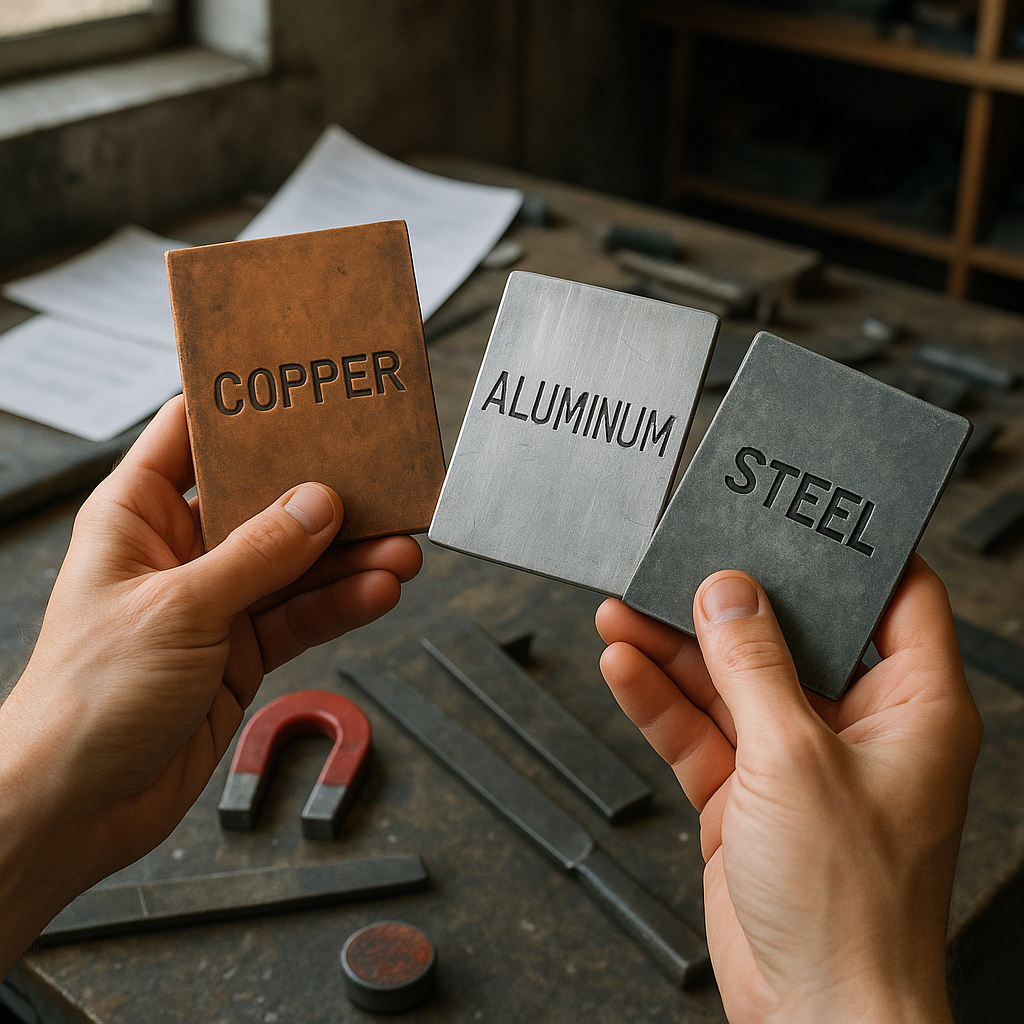5901 Botham Jean Blvd, Dallas, TX 75215
Scrap Metal Prices and Value: Identify, Sort, and Sell for Maximum Profit
August 20, 2025The global scrap metal recycling market is projected to reach $77 billion by 2028. This expansive industry converts discarded materials into valuable resources, providing income opportunities for individuals and businesses. Knowing how to assess the value of your scrap metal before selling is crucial to ensure fair compensation.
Scrap metal prices fluctuate often, sometimes changing by 10-15% within a single month due to market conditions. This volatility makes valuation knowledge essential for anyone aiming to maximize profits in the recycling market.
The gap between informed and uninformed selling can be significant. Copper generally offers 30-40 times more value than steel. Brass typically fetches about half of copper’s price, while aluminum earns roughly one-fifth of copper’s value. Understanding what you have and its worth enables you to make profitable decisions in the scrap metal marketplace.
What Factors Affect Scrap Metal Prices?

Scrap metal prices fluctuate constantly due to a complex interplay of market forces. These variations can significantly impact the profitability of recycling operations and influence when sellers choose to bring their materials to market. Several key factors drive these price movements in the recycling economy.
Global Supply and Demand
The fundamental economic principle of supply and demand is the primary driver of scrap metal pricing. When industries like construction, automotive manufacturing, and technology grow, demand for metals rises sharply, increasing scrap prices accordingly.
Conversely, when these sectors slow down, demand weakens, causing prices to fall. For example, during the early phases of the COVID-19 pandemic, many manufacturing facilities temporarily closed, causing scrap metal prices to drop by nearly 30% in some regions as demand collapsed.
The balance between material availability and industrial requirements creates a constant push-pull effect on pricing. Recyclers tracking these industry trends can better anticipate market movements and plan their selling strategies.
Economic Conditions
Broader economic health directly impacts scrap metal values. During periods of economic expansion, industrial production typically increases, driving up demand for raw materials, including recycled metals. Strong economic indicators like GDP growth, low unemployment, and robust manufacturing output generally correlate with higher scrap prices.
Economic downturns have the opposite effect. Recessions lead to reduced industrial activity, lower consumption, and decreased demand for metals. The ripple effects from major economic events can trigger price volatility that persists for months.
International economic conditions matter too. Growth in developing economies with expanding infrastructure and manufacturing sectors can drive significant demand for scrap metal, influencing global prices.
Energy Costs
The recycling process requires substantial energy input, particularly for metals that need to be melted down and reprocessed. When energy prices rise, operating costs for recycling facilities increase. These higher production expenses often translate to lower prices offered for incoming scrap materials as recyclers try to maintain profit margins.
This relationship makes scrap metal prices sensitive to fluctuations in electricity rates, natural gas, and other fuel costs. Regions with lower energy costs may offer better scrap prices than areas where energy is more expensive.
Virgin Metal Prices
Scrap metal prices typically move in tandem with the cost of newly mined (virgin) metals. When mining operations face challenges like labor strikes, resource depletion, or regulatory restrictions, virgin metal prices rise, making recycled alternatives more attractive and driving up scrap values.
Similarly, if mining becomes more efficient or new deposits are discovered, virgin metal prices may drop, pulling scrap values down with them. Monitoring commodity markets for primary metals provides valuable insights into potential scrap price movements.
Regional Price Differences
Scrap metal prices vary significantly by location due to transportation costs, local supply and demand dynamics, and proximity to end users. Areas near steel mills, foundries, or export terminals often command better prices than remote locations with higher transportation costs.
These regional differences create opportunities for arbitrage but also present challenges for sellers with limited mobility. Understanding your local market conditions relative to national trends helps set realistic price expectations.
Seasonal Variations
Scrap metal collection and processing follow seasonal patterns. Construction activity typically increases during spring and summer months in many regions, boosting demand for structural metals. Conversely, winter weather can slow demolition and construction projects, reducing both the supply of and demand for scrap.
Vehicle scrapping also shows seasonal patterns, with more end-of-life vehicles processed after severe winter weather damages older cars. These predictable annual cycles create opportunities for sellers to time their transactions for maximum value.
Currency Exchange Rates
For internationally traded scrap metals, currency fluctuations play a significant role in pricing. Since global metal trading typically occurs in US dollars, exchange rate movements can impact the effective price paid in local currencies.
A strengthening dollar makes US exports more expensive for foreign buyers, potentially reducing international demand. Conversely, a weakening dollar can stimulate export demand and drive domestic prices higher. Recyclers involved in export markets must watch currency trends closely.
- Global industrial demand drives baseline scrap values
- Energy costs affect processing margins and pricing
- Economic conditions influence overall market activity
- Virgin metal prices create price ceilings for comparable scrap
- Regional market conditions cause local price variations
- Seasonal patterns create predictable price cycles
- Currency fluctuations impact international trading
A real-world example of these factors in action occurred in early 2023, when Turkey—a major global scrap metal importer—increased its purchases of HMS 1/2 80:20 scrap by 1.7%, reaching $355 per ton. This surge in demand from a key international buyer helped reverse a downward price trend that had dominated the previous month, highlighting how quickly global demand shifts can impact the entire market.
How Can You Identify Different Types of Scrap Metals?

Accurately identifying scrap metals is crucial for maximizing their recycling value. Properly sorted metals fetch significantly higher payouts than mixed batches. Recyclers use several reliable techniques to distinguish between different metal types.
The primary distinction in scrap metal sorting is between ferrous and non-ferrous metals. Ferrous metals contain iron and are generally less valuable than non-ferrous metals. Non-ferrous metals like copper, aluminum, and brass typically command higher prices in recycling markets.
Visual Inspection Methods
Color is a key identifier for scrap metals. Copper has a distinctive reddish-brown hue, while brass appears yellowish, similar to gold but darker. Aluminum is silvery-white with a matte finish, and stainless steel is a bright, reflective silver.
Surface characteristics also offer clues. Aluminum feels lightweight and has a dull luster compared to other metals. Steel often has a rougher texture, while copper and brass typically exhibit smoother surfaces unless corroded.
Oxidation patterns provide further identification. Copper develops a greenish patina when exposed to air and moisture, while iron and steel form reddish-brown rust. Aluminum oxide appears as a whitish powder on the surface.
Testing Methods for Metal Identification
The magnet test is a simple and effective method to sort metals. If a magnet sticks to the metal, it is ferrous, like steel or iron. Non-ferrous metals such as copper, aluminum, brass, and many grades of stainless steel do not attract magnets.
Comparing weight can differentiate similar-looking metals. Aluminum is notably lighter than steel or copper of the same size, while lead is remarkably heavy for its volume. This density difference helps distinguish between metals that might appear similar.
Hardness testing involves scratching the surface with a file or another metal. Aluminum scratches easily, whereas stainless steel offers significant resistance. Copper is intermediate in hardness. This test can help confirm initial identifications.
Identifying Valuable Non-Ferrous Metals
Copper is among the most valuable common scrap metals. Found in plumbing pipes, electrical wiring, and electronics, its high conductivity makes it essential for many industries. Clean copper without attachments or coatings commands the highest prices.
Brass, an alloy of copper and zinc, is used in plumbing fixtures, decorative items, and musical instruments. Its golden color and resistance to corrosion make it highly recyclable, offering good value but less than pure copper.
Aluminum, while less valuable per pound than copper or brass, is worth collecting due to its abundance. It is found in beverage cans, window frames, siding, and vehicle parts. Its lightweight nature makes it easy to amass in large quantities.
Stainless steel contains chromium, making it resistant to corrosion and staining. It is commonly used in kitchen appliances, cookware, and industrial equipment and offers moderate recycling value. Unlike regular steel, many grades of stainless steel aren’t magnetic.
| Metal | Common Uses | Identification Characteristics | Magnetic |
|---|---|---|---|
| Copper | Plumbing, electrical wiring, roofing | Fiery red-orange with hints of browns; malleable | No |
| Aluminum | Cans, siding, car parts | Silvery-white with a matte finish; lightweight | No |
| Brass | Plumbing fixtures, musical instruments, decorative items | Yellow-brown, golden color; quite hard | No |
| Steel | Appliances, construction materials, vehicles | Silvery, shiny finish; rougher texture | Yes |
| Lead | Batteries, old water pipes | Very heavy; a dull grey color | No |
| Iron | Radiators, gates, railings | Forms reddish-brown rust | Yes |
Advanced Identification Techniques
For more precise identification, especially of alloys and specialty metals, recyclers sometimes use spark testing. When grinding against a wheel, different metals produce characteristic spark patterns. Steel creates bright, branching sparks, while aluminum produces few or no sparks.
Chemical testing can identify specific metal compositions. A drop of nitric acid on copper turns bluish-green, while on silver it creates a creamy white substance. However, these tests require proper safety equipment and knowledge.
Professional recycling facilities often use X-ray fluorescence analyzers or optical emission spectrometers for exact metal identification. These devices can determine precise alloy compositions within seconds, ensuring accurate grading and pricing.
Tips for Effective Scrap Metal Sorting
Clean metals before identification and recycling. Remove non-metal attachments, insulation, or coatings when possible. Clean metals receive higher prices and are easier to identify accurately.
Sort metals into separate containers based on type. Keep ferrous and non-ferrous metals separate at minimum. To maximize value, further sort into specific categories like copper, aluminum, brass, and stainless steel.
If uncertain about a metal type, set it aside for further testing or consult professionals at your recycling center. Mixing unknown metals with identified batches can reduce the value of the entire lot.
What Are the Best Practices for Preparing Scrap Metal for Sale?

Properly preparing scrap metal before selling can significantly increase its value and ensure the best possible return on your materials. The preparation process involves several key steps that can transform a jumbled pile of metal into organized, high-value recyclable material.
Sort Your Metals by Type
The foundation of effective scrap metal preparation is proper sorting. Different metals command vastly different prices in the recycling market. Begin by separating your scrap into two main categories:
Ferrous metals contain iron and are magnetic, such as steel, cast iron, and wrought iron. While they are typically less valuable per pound than non-ferrous metals, they can still generate decent returns when properly prepared.
Non-ferrous metals aren’t magnetic and generally command higher prices. These include copper, aluminum, brass, stainless steel, and zinc. A simple magnet test can help you differentiate between these two categories.
After the initial separation, further sort your metals by specific type. For example, separate copper pipes from copper wiring, and aluminum cans from aluminum siding. This detailed sorting maximizes your potential earnings.
Remove Non-Metal Attachments
Metal recyclers want pure metal, not components made of plastic, rubber, wood, or other materials. Removing these non-metal attachments increases the value of your scrap and prevents price reductions at the yard.
For appliances, remove plastic handles, rubber gaskets, and electronic components. When recycling wiring, consider stripping the insulation to expose the valuable copper inside. While time-consuming, this process can substantially increase your payout for certain materials.
Focus your efforts strategically. Removing plastic from high-value metals like copper and brass yields better returns than spending excessive time on lower-value ferrous metals.
Clean Contaminants Thoroughly
Clean metal is more valuable than dirty metal. Contaminants like dirt, grease, paint, and rust reduce the metal’s purity and, consequently, its value. Take time to clean your scrap before transport.
Use a wire brush to remove surface rust from ferrous metals. For greasy components, degreasers or simple soap and water can work effectively. Clean metals not only fetch better prices but also create a more positive impression with scrap yard operators.
Be particularly diligent with valuable metals like copper. Even a thin layer of corrosion can downgrade copper from “number one”
Conclusion: Maximizing Your Scrap Metal’s Value

Maximizing the value of your scrap metal requires a strategic approach that combines market awareness with proper preparation techniques. Understanding market fluctuations, accurately identifying different metal types, thoroughly cleaning and sorting materials, and establishing relationships with reputable buyers are all essential to a successful scrap metal recycling strategy. These practices not only boost your profit potential but also support sustainable resource management and environmental conservation.
The recycling industry is continually evolving, with technological advancements improving metal recovery efficiency and market demands changing based on global economic factors. Staying informed about these trends and continuously refining your approach to recycling will help you maintain a competitive edge in this lucrative market. Remember, even small improvements in your preparation and selling methods can lead to significant financial benefits over time.
For professional guidance on maximizing your scrap metal’s value or to partner with a trusted recycling provider, contact Okon Recycling at 214-717-4083.
